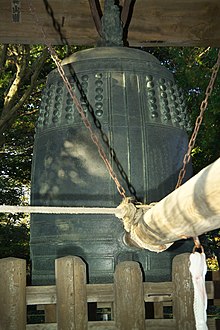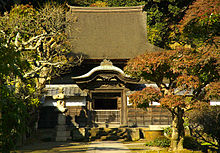Engaku-ji
This article includes alist of references,related reading,orexternal links,but its sources remain unclear because it lacksinline citations.(December 2022) |
| Engaku-ji Viên 覚 tự | |
|---|---|
 The stairs leading to theSanmon | |
| Religion | |
| Affiliation | Engaku-jiRinzai |
| Deity | Houkan Shaka(Jewel-crown Śākyamuni) |
| Status | Head Temple,Five Mountain Temple (Kamakura) |
| Location | |
| Location | 409Yamanouchi,Kamakura,Kanagawa Prefecture |
| Country | Japan |
| Geographic coordinates | 35°20′16″N139°32′51″E/ 35.3377°N 139.5475°E |
| Architecture | |
| Founder | Hōjō TokimuneandMugaku Sogen |
| Completed | 1964 (Reconstruction) |
| Website | |
| http://www.engakuji.or.jp/(in Japanese) | |
Zuirokusan Engaku Kōshō Zenji(Thụy lộc sơn viên 覚 hưng thánh thiền tự),orEngaku-ji( viên 覚 tự ), is one of the most importantZen Buddhisttemplecomplexes inJapanand is ranked second among Kamakura'sFive Mountains.It is situated in thecityofKamakura,inKanagawa Prefectureto the south ofTokyo.
Founded in 1282 (Kamakura period,the temple maintains the classical Japanese Zen monastic design, and both the Shariden and the Great Bell(Đại chung,Ogane)are designatedNational Treasures.Engaku-ji is one of the twenty-two historic sites included inKamakura's proposalfor inclusion inUNESCO'sWorld Heritage Sites.
It is located inKita-Kamakura,very close toKita-Kamakura Stationon theYokosuka Line,and indeed the railway tracks cut across the formal entrance to the temple compound, which is by a path beside a pond which is crossed by a small bridge.
History
[edit]
The temple was founded in 1282 by a Chinese ZenmonkMugaku Sōgen(1226-1286) at the request of the then ruler of Japan, theregentHōjō Tokimuneafter he had repelled aMongolian invasion in the period 1274 to 1281.Tokimune had a long-standing commitment to Zen and the temple was intended to honour those of both sides who died in the war, as well as serving as a centre from which the influence of Zen could be spread. According to the records of the time, when building work started a copy of theSutra of Perfect Enlightenment(in Japanese,engaku-kyōViên 覚 kinh ) was dug out of the hillside in a stone chest during the initial building works, giving its name to the temple.
The fortunes of the temple have waxed and waned over the centuries. Its present form is owed to the ZenpriestSeisetsu Shucho(1745–1820), also known as Daiyu Kokushi, who reconstructed and consolidated it towards the end of theEdoera. A particularly important year for these reforms and the history of the temple was 1785, the "500th Anniversary of the Foundation". In theMeijiera, Engaku-ji became the chief centre for Zen instruction in theKantōregion;Imakita KōsenandSoyen Shakuwere successivelyabbotsin this period, andDaisetz Teitaro Suzukiwas a student under them.
Zazencourses are still held in the temple, with open meditations sessions every morning (except for New Year's and early October) and every Saturday afternoon (except for August). There's also a sermon the 2nd and 4th Sunday of the month at 9:00 am, followed by a session of zazen. These activities are held at the main hall (Butsuden), Kojirin and Hojo buildings respectively. A four-day "Summer Lecture Series" is organized yearly in late July.
Architecture
[edit]Fire has damaged many of the buildings at different times, and the dates given below refer to the building of the structures currently seen. From the entrance, the buildings of the temple rise up a wooded hillside, with the major buildings in a straight line in the perpendicular zen style; the austere buildings and the trees blending in a satisfying overall composition. There are altogether 18 temples on the site.









Sanmon
[edit]The two-storied main gate, orSanmon(Sơn môn),was rebuilt in 1785, as part of the reconstruction works led by Seisetsu. A wooden plaque of calligraphic work by theEmperor Fushimi(1265-1317) reads "Engaku Kōshō Zenji". On the upper floor there are statues enshrined ofBodhisattva,theSixteen Arhatsand theTwelve Heavenly Generals.The roof is covered with copper.
It is designated an Important Cultural Property of theKanagawa Prefecture.
Butsuden
[edit]The large modernButsuden(Phật điện)(; main hall;[1]) at the center of the Engaku-ji complex was rebuilt in 1964, after it was destroyed by theGreat Kanto Earthquake.The construction of this new building, surrounded byjunipers,was made following closely a plan from 1573.
It is dedicated toHokan Shaka Nyorai(Shakyamuniwith a Jeweled Crown), enshrined there, the main object of worship of the temple. This seated statue dates from the lateKamakura period.Statues of Bonten and Taishakuten in the same hall date from 1692. A painting of a dragon in the ceiling was painted by Tadashi Moriya under the supervision ofSeison Maeda.
Above the front entrance there is a plaque of calligraphy fromEmperor Go-Kogon(1338–74) which readsDaikomyohoden.
Sembutsudo and Kojirin
[edit]Sembutsudo(Tuyển phật đường)is a thatch-roofed hall for Zen meditation and a sutra repository, built in 1699.
The Kojirin(Cư sĩ lâm)is a Zen meditation hall for lay trainees (Koji). Meditation sessions are held here most Sundays, both for first-time participants and for the general public.
Both building stand left of the Butsuden, and are open to the public.
Ogane (National Treasure) and Bentendo
[edit]Cast by Mononobe Kunimitsu in August 1301, the Great Bell(Đại chung,Ogane)of Engaku-ji is at 2.6 metres tall the largest of all the many temple bells of Kamakura (in fact the largest inKantō.It was made by order ofHojo Sadatoki(1271-1311), after he confined himself in theBenzaitenshrine inEnoshima.
This bell and the one atKenchō-jiare the only ones designatedNational Treasurein that category of crafts in the Kanagawa prefecture (also the only ones from theKamakura period).
Awaniguchigong from 1540 hangs in the belfry. It designated an Important Cultural Property.
Bentendo(Biện thiên đường)is dedicated to theBenzaitenshrine inEnoshima.According to the legend, the cast of the Ogane successful thanks to the protection ofBenzaiten.Once every 60 years a grand ceremony is held between both temples.
Shariden (National Treasure)
[edit]The Shariden(Xá lợi điện)(reliquary hall[2]), is a 3×3 hall, single-storied,irimoyastyle, with a pent roof enclosure, covered withhinoki cypressbark shingles. It is the only building with the designation ofNational Treasurein the Kanagawa prefecture.
The original structure, built in 1285 byHōjō Sadatoki(1271-1311), was destroyed by a fire in 1563. The current building was transferred from the Taiheiji convent inNishi Mikado,but it still dates from theMuromachi period.
The structure is typical of kara-yo (Chinese-style architecture), also called Zenshu-yo (Zen-sect-style), introduced from China in theKamakura period,with a style close to that of theSong dynasty.It houses what is claimed to be a tooth ofShakyamuni,presented by the Noninji Temple in China toMinamoto no Sanetomo.
Other structures
[edit]Among the other buildings and monuments are:
- Kaikibyo
- Shozokuin
- Kojirin
- Hojo
- the thatched Butsunichian ( phật nhật am ) which is the burial site of Hōjō Tokimune;
- Obaiin ( hoàng mai viện ), a small thatched temple containing a statue ofKannon;
- grave of film directorYasujirō Ozu,markedmu(Vô,nothingness)[3]
Access and amenities
[edit]There is an admission fee (as of 2017[update],300yen) for visitors to enter the temple complex, and additional similar charges to enter a few of the buildings. Booths selling tourist items are located near the entrance, below the Sanmon, and there are refreshment facilities in the garden of the Shariden and at the platform where the Great Bell is located, from where there are extensive views across the valley to other temple complexes in theKita-Kamakuraneighbourhood, such asJōchi-jiandTōkei-ji(another temple of the Engaku-ji school).
Annual Events
[edit]- Nehane (Shakyamuni's Nirvana Ceremony) February 15
- Gotane (Birthday of Shakyamuni) and Hana Matsuri (Flower Festival) April 8
- Kaisanki (Anniversary of the Founder's death) October 3
- Darumaki (Anniversary of Bodhidharma's death) October 15
- Homotsu Kazeire (Treasures Exhibition) around November 3 (three days)
- Jodoe (Anniversary of Shakyamuni's Enlightenment) December 8
See also
[edit]- For an explanation of terms concerning Japanese Buddhism, Japanese Buddhist art, and Japanese Buddhist temple architecture, see theGlossary of Japanese Buddhism.
- List of National Treasures of Japan (crafts-others)
Notes
[edit]- ^Butsuden phật điệnat Japanese Architecture and Art Net Users System
- ^Shariden xá lợi điệnat Japanese Architecture and Art Net Users System
- ^Desser, David(1997).Ozu's Tokyo Story (Cambridge Film Handbooks).Cambridge University Press.p. 102.ISBN978-0-521-48435-0.
References
[edit]- Richmond, S., & Dodd, J. (2005).Rough guide to Japan,3rd edn. New York: Rough Guides.
- Information leaflet issued by the temple authorities
External links
[edit] Kamakuratravel guide from Wikivoyage
Kamakuratravel guide from Wikivoyage- Official website(in Japanese)
- Engakuji TempleatKamakura: History & Historic Sites
- Engakuji(overview)
